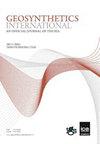基于低场核磁共振技术的PVC-P土工膜渗透机理研究
IF 3.3
2区 工程技术
Q2 ENGINEERING, GEOLOGICAL
引用次数: 0
摘要
增塑聚氯乙烯(PVC-P)土工膜(GMBs)的渗透性对防渗结构甚至工程的安全运行具有重要意义。为了克服传统上采用渗透率系数来表征渗透率的缺点,本文根据垂直渗透率测试结果和低场核磁共振(NMR)测试获得的孔隙度,提出了孔隙度和渗流的数学模型,结合孔隙和孔隙半径的动态分布,探讨了孔隙度评价渗透率的适用性。结果表明,以1H原子为探针的低场NMR技术可以准确地测量PVC-P GMB中的孔隙分布和孔隙半径。微孔(Mic)、中孔(Mes)和大孔(Mac)的比例以及孔径的收缩或发展是孔隙率变化的主要原因。孔隙率与渗流流量密切相关,所建立的模型能够准确预测渗流流量。此外,孔隙率可以为评估PVC-P GMBs的渗透性和为工程设计选择合适的GMBs提供技术支持。本文章由计算机程序翻译,如有差异,请以英文原文为准。
Permeability mechanism of PVC-P geomembranes based on low-field NMR technology
The permeability of plasticized polyvinyl chloride (PVC-P) geomembranes (GMBs) is of significant importance to the safe operation of the impermeable structures and even the project. To avoid the drawbacks of adopting the permeability coefficient to characterize permeability traditionally, this paper presents a mathematical model of porosity and seepage discharge based on the results of the vertical permeability test and porosity obtained from low-field nuclear magnetic resonance (NMR) test, and the applicability of porosity to evaluate the permeability was explored combined with the dynamic distribution of pores and pore radius. The results show that the low-field NMR technology with 1H atoms as the probe can accurately measure the distribution of pores and pore radius in the PVC-P GMB. The proportion of micropores (Mic), mesopores (Mes) and macropores (Mac) and the shrinkage or development of pore radius are primarily responsible for the variation of the porosity. The porosity is closely correlated with the seepage discharge, and the constructed model can accurately predict the seepage discharge. Furthermore, the porosity can provide technical support for the evaluation of the permeability of PVC-P GMBs and the selection of appropriate GMBs for engineering design.
求助全文
通过发布文献求助,成功后即可免费获取论文全文。
去求助
来源期刊

Geosynthetics International
ENGINEERING, GEOLOGICAL-GEOSCIENCES, MULTIDISCIPLINARY
CiteScore
6.90
自引率
20.00%
发文量
91
审稿时长
>12 weeks
期刊介绍:
An online only, rapid publication journal, Geosynthetics International – an official journal of the International Geosynthetics Society (IGS) – publishes the best information on current geosynthetics technology in research, design innovation, new materials and construction practice.
Topics covered
The whole of geosynthetic materials (including natural fibre products) such as research, behaviour, performance analysis, testing, design, construction methods, case histories and field experience. Geosynthetics International is received by all members of the IGS as part of their membership, and is published in e-only format six times a year.
 求助内容:
求助内容: 应助结果提醒方式:
应助结果提醒方式:


